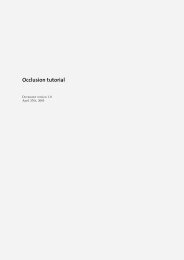mental ray Architectural and Design Visualization Shader Library
mental ray Architectural and Design Visualization Shader Library
mental ray Architectural and Design Visualization Shader Library
You also want an ePaper? Increase the reach of your titles
YUMPU automatically turns print PDFs into web optimized ePapers that Google loves.
116 5 General Utility <strong>Shader</strong>sThe leftmost sphere uses mia light surface with a manual setting, i.e. use lights is off. Theuser is responsible for making sure the intensity <strong>and</strong> color of the surface is “correct”, as wellas manually keeping it in sync with any animated intensity changes etc.The center sphere uses use lights, but we get a very strange effect from it; half our lightbulbis dark. This is because the IES profile we chose only emits light in the down direction. Sincethe light source is in the center of the sphere, only the lower half of the sphere will gather anyintensity values off the light!Clearly this is not desirable; the IES profile is a compound effect applying to the entireluminaire, <strong>and</strong> should not be “painted” onto the light bulb itself!The solution is to use lights eval point as is done on the rightmost sphere. Here a point justin front of the light is picked (in the lights own coordinate space) as the “evaluation point”.Each point on the sphere (regardless of its location) will have the intensity “measured” at thatpoint in space.This gives the sphere a color that automatically follows any intensity- <strong>and</strong> color-changes ofthe light, yet is uniform across the surface of the sphere. This sphere will reflect correctly ina more plausible way than a traditional “highlight” would.In conclusion: The mia light surface shader allows...• ...creating a surface as a “st<strong>and</strong> in” for an existing light, that “looks” bright, withoutemitting additional light into the scene.• ...controlling the amount of reflection <strong>and</strong> light actually introduced into the scene.• ...driving the appearance of the surface from an existing light source.• ...more physically correct “highlights” by replacing them with glossy reflections of actualhigh-intensity objects.
















